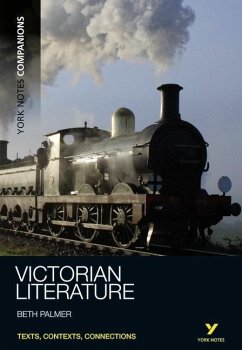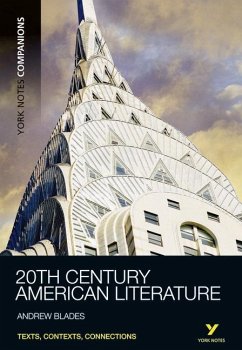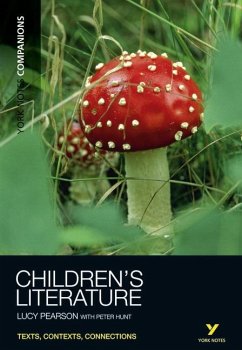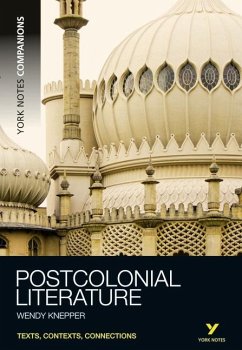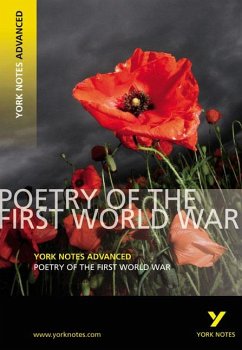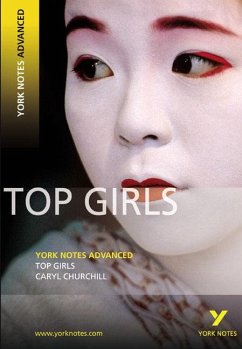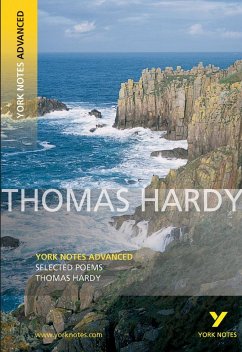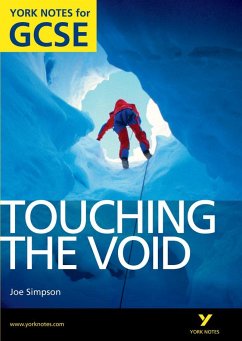
York Notes Companions: Romantic Literature
Versandkostenfrei!
Versandfertig in 2-4 Wochen
19,99 €
inkl. MwSt.

PAYBACK Punkte
10 °P sammeln!
The literature of the Romantic era is steeped in the politics of revolution and reaction. This Companion looks at first and second generation poets such as Wordsworth, Blake, Byron and Shelley and explores their engagement with the turbulent history of their times. Other genres such as drama, fiction and travel writing are also discussed, with close attention paid to texts by Walpole, Austen and Mary Wollstonecraft. Combining thematic analysis with modern critical perspectives, the volume also includes key contextual sections focusing on Imagination, Truth and Reason, Heroes and Anti-heroes and Faith, Myth and Doubt.
Product Description
The literature of the Romantic era is steeped in the politics of revolution and reaction. This volume looks at first and second generation poets such as Wordsworth, Blake, Byron and Shelley and explores their engagement with the turbulent history of their times. Other genres such as drama, fiction and travel writing are also discussed, with close attention paid to texts by Walpole, Austen and Mary Wollstonecraft. Combining thematic analysis with modern critical perspectives, the volume also includes key contextual sections focusing on Imagination, Truth and Reason, Heroes and Anti-heroes and Faith, Doubt and Myth.
Features + Benefits
Analysis of key texts and debates
Extended commentaries provide further in-depth analysis of individual texts
Notes contain extra context and explanations of literary terms
Historical, social and cultural contexts explored in introductory chapters and alongside discussions
Modern critical theory and perspectives in practice
Timelines and annotated further reading
Backcover
5) Romantic Literature
The York Notes Companion to Romantic Literature is a comprehensive introduction to the literature of an era steeped in the politics of revolution and reaction. Examining the works of first and second generation poets such as Wordsworth, Blake, Byron and Shelley alongside drama, fiction and travel writing, the Companion explores the central themes of imagination, truth and reason, heroes and anti-heroes, faith and myth, offering close readings of texts, and guiding students through key literary theories and debates. Connecting texts with their historical and scholarly contexts, this is essential reading for any student of romantic literature.
Each York Notes Companion provides:
Analysis of key texts and debates
Extended commentaries for further in-depth analysis of individual texts
Exploration of historical, social and cultural contexts
Annotations clarifying literary terms and events in history
Modern theoretical perspectives in practice
Timelines and annotated further reading
John Gilroy is a lecturer in English at Anglia Ruskin University, Cambridge, and lectures for the University of Cambridge Institute of Continuing Education.
Part One: Introduction
Part Two: A Cultural Overview
Part Three: Texts, Writers and Contexts
Writing in Revolution: Edmund Burke, Thomas Paine and William Wordsworth
Extended commentary: Wordsworth, The Prelude (1850), Book IX, lines 436 504
Revolution, Reaction and the Natural World: Wordsworth and Coleridge, John Clare and William Blake
Extended commentary: Blake, The Tyger from Songs of Experience (1793)
Dramatic writing: Horace Walpole, Robert Southey and Lord Byron
Extended commentary: Walpole, The Mysterious Mother (1768), V.i.312420
Romantic Verse Narratives: John Keats, Percy Bysshe Shelley, Samuel Taylor Coleridge
Extended commentary: The Rime of the Ancyent Mariner (1817), lines 140 and 61017
Romantic Fiction: James Hogg, Thomas Love Peacock and Jane Austen
Extended commentary: Austen, Persuasion (1816), Chapter 23
Romantic Travel Writing: William Beckford, Lord Byron and Mary Wollstonecraft
Extended commentary: Mary Wollstonecraft, Letters Written during a Short Residence in Sweden, Norway, and Denmark (1796), Letters 16 and 17
Part Four: Critical Theories and Debates
Imagination, Truth and Reason
Faith, Myth and Doubt
Heroes and Ant-Heroes
Forms of Ruin
Part Five: References and resources
Timeline
Further reading
Index
Product Description
The literature of the Romantic era is steeped in the politics of revolution and reaction. This volume looks at first and second generation poets such as Wordsworth, Blake, Byron and Shelley and explores their engagement with the turbulent history of their times. Other genres such as drama, fiction and travel writing are also discussed, with close attention paid to texts by Walpole, Austen and Mary Wollstonecraft. Combining thematic analysis with modern critical perspectives, the volume also includes key contextual sections focusing on Imagination, Truth and Reason, Heroes and Anti-heroes and Faith, Doubt and Myth.
Features + Benefits
Analysis of key texts and debates
Extended commentaries provide further in-depth analysis of individual texts
Notes contain extra context and explanations of literary terms
Historical, social and cultural contexts explored in introductory chapters and alongside discussions
Modern critical theory and perspectives in practice
Timelines and annotated further reading
Backcover
5) Romantic Literature
The York Notes Companion to Romantic Literature is a comprehensive introduction to the literature of an era steeped in the politics of revolution and reaction. Examining the works of first and second generation poets such as Wordsworth, Blake, Byron and Shelley alongside drama, fiction and travel writing, the Companion explores the central themes of imagination, truth and reason, heroes and anti-heroes, faith and myth, offering close readings of texts, and guiding students through key literary theories and debates. Connecting texts with their historical and scholarly contexts, this is essential reading for any student of romantic literature.
Each York Notes Companion provides:
Analysis of key texts and debates
Extended commentaries for further in-depth analysis of individual texts
Exploration of historical, social and cultural contexts
Annotations clarifying literary terms and events in history
Modern theoretical perspectives in practice
Timelines and annotated further reading
John Gilroy is a lecturer in English at Anglia Ruskin University, Cambridge, and lectures for the University of Cambridge Institute of Continuing Education.
Part One: Introduction
Part Two: A Cultural Overview
Part Three: Texts, Writers and Contexts
Writing in Revolution: Edmund Burke, Thomas Paine and William Wordsworth
Extended commentary: Wordsworth, The Prelude (1850), Book IX, lines 436 504
Revolution, Reaction and the Natural World: Wordsworth and Coleridge, John Clare and William Blake
Extended commentary: Blake, The Tyger from Songs of Experience (1793)
Dramatic writing: Horace Walpole, Robert Southey and Lord Byron
Extended commentary: Walpole, The Mysterious Mother (1768), V.i.312420
Romantic Verse Narratives: John Keats, Percy Bysshe Shelley, Samuel Taylor Coleridge
Extended commentary: The Rime of the Ancyent Mariner (1817), lines 140 and 61017
Romantic Fiction: James Hogg, Thomas Love Peacock and Jane Austen
Extended commentary: Austen, Persuasion (1816), Chapter 23
Romantic Travel Writing: William Beckford, Lord Byron and Mary Wollstonecraft
Extended commentary: Mary Wollstonecraft, Letters Written during a Short Residence in Sweden, Norway, and Denmark (1796), Letters 16 and 17
Part Four: Critical Theories and Debates
Imagination, Truth and Reason
Faith, Myth and Doubt
Heroes and Ant-Heroes
Forms of Ruin
Part Five: References and resources
Timeline
Further reading
Index
The literature of the Romantic era is steeped in the politics of revolution and reaction. This Companion looks at first and second generation poets such as Wordsworth, Blake, Byron and Shelley and explores their engagement with the turbulent history of their times. Other genres such as drama, fiction and travel writing are also discussed, with close attention paid to texts by Walpole, Austen and Mary Wollstonecraft. Combining thematic analysis with modern critical perspectives, the volume also includes key contextual sections focusing on ?Imagination, Truth and Reason?, ?Heroes and Anti-heroes? and ?Faith, Myth and Doubt?.



